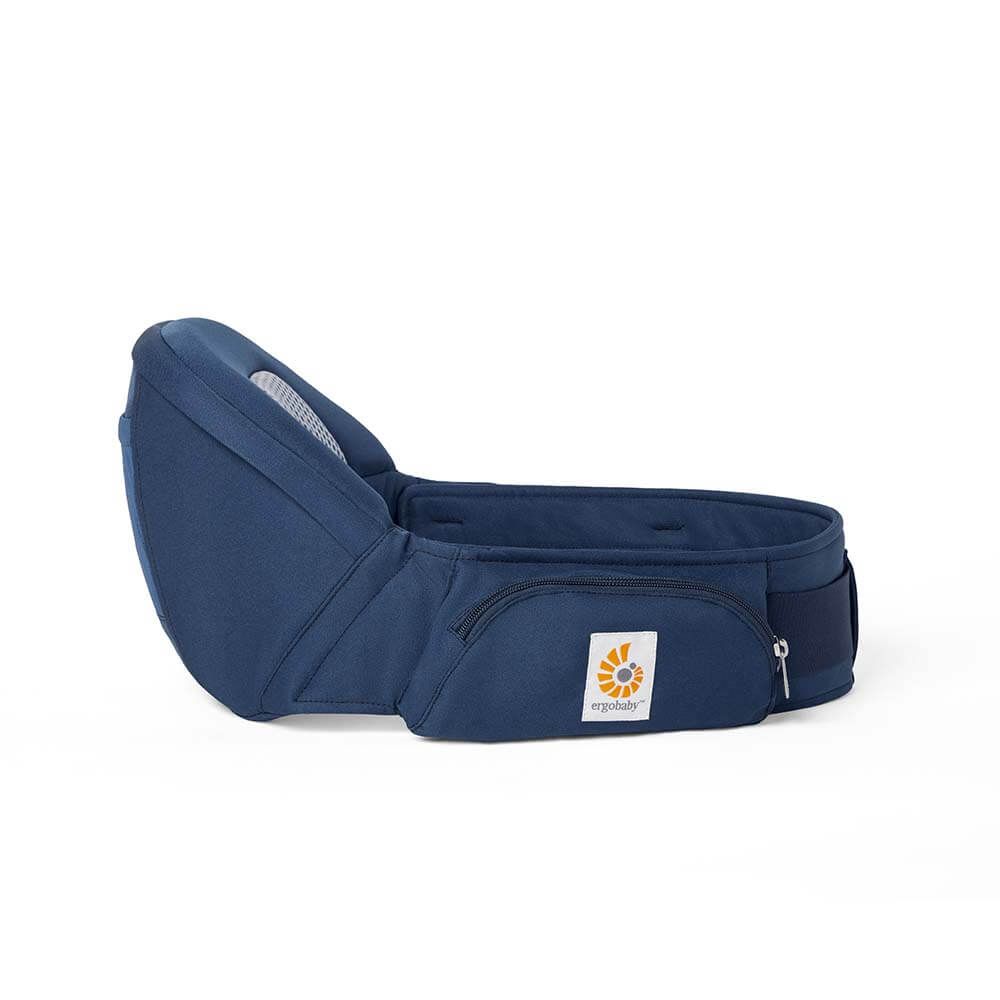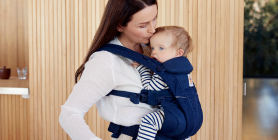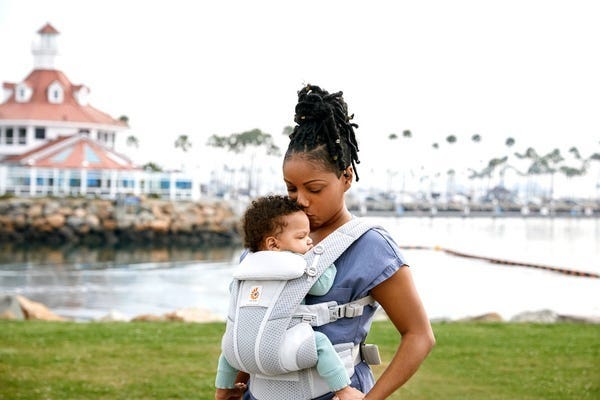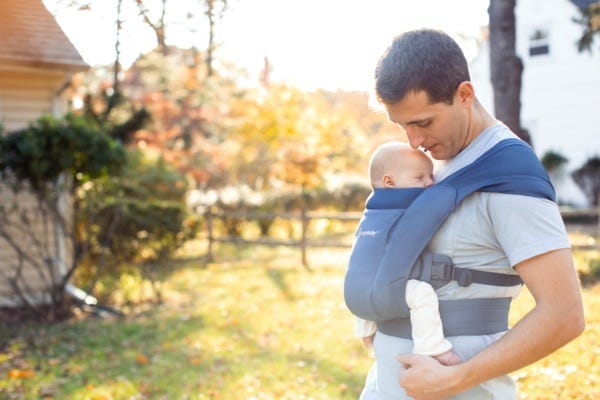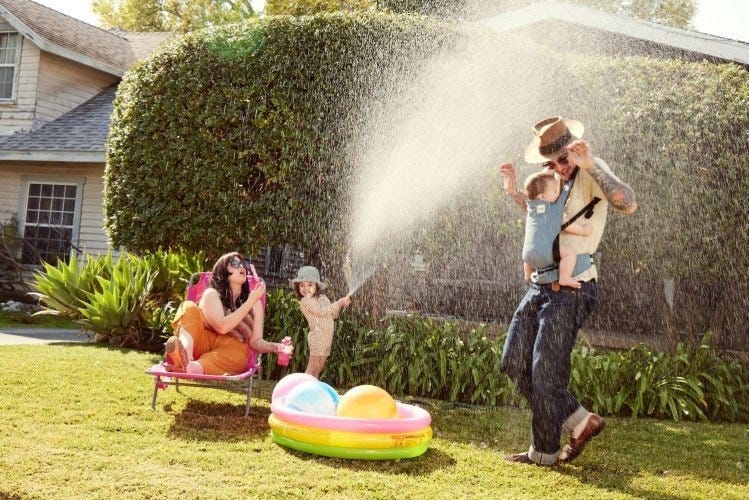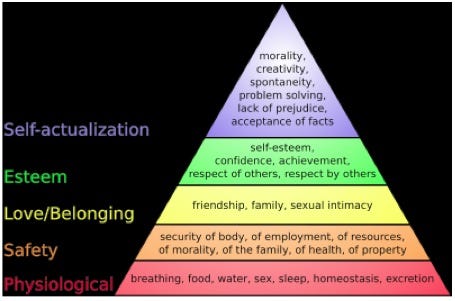
...I once told a group of environmental activists, "You can save a forest today, but if we don't raise children consciously, it will be cut down tomorrow." From this perspective we see that the well being of children sits at the root of every endeavour. With out happy, healthy children, we have no forest, no peace, and no world.
A powerful body of research grounded in the fields of neuroscience, psychology, biology and genetics points us towards the importance of the early years and how bonding, or the lack of it, dictates a child's sense of his relationship to the world and himself. We as parents literally have in our hands, the ability to create a violent culture or a peaceful one.
(* Ecologist and Editor of Kindred magazine, one of the world's most endorsed parenting journals, Kali Wendorf is a passionate advocate of social change; particularly as it relates to the role of parents in our society. She feels that any movement to address any of our society's woes, including climate change or environmental degradation, is pointless unless the importance of bonding between the child and parents is addressed and acknowledged in public policy: "Because sustainability begins at conception." She lives in Mullumbimby, Australia with her family.)
Kindred Magazine, Vol. 9 March, 2004 "Our Child, Not Mine Ending the parent blame-game"The above excerpt illustrates perfectly the relationship between "parenting" the earth and parenting our children. The two are inseparable: our future rests in the hands of the children we raise, the values we impart on them, and the way they learn to perceive their relationship with the planet. The survival of our planet is determined by how we choose to raise our children! In order to change the destructive path we are currently on; pollution, nuclear waste, endless drilling for more oil, overpopulation, poverty, imminent extinction of many of our species; we need to cherish our young, nurture and help them maintain their connection to humanity, and ultimately, to the planet. A child cannot care for others if she is not cared for first. She cannot nurture another without being nurtured herself. Children who mature without these basic needs become adults incapable of giving unconditional love, support, and sympathy. According to Abraham Maslow, a widely respected humanistic psychologist, a person's basic needs must be met in order for him to progress to the next level of needs, and then to the next; ultimately becoming a conscious and fully self-actualized individual. These five levels of needs, portrayed in the pyramid below, progress from the most basic - Physiological, as in the need for oxygen, food, and water - to the most advanced - the Need for Self-Actualization, or the desire to achieve what we were "born to do".
MASLOW'S HIERARCHY OF NEEDS
According to this hierarchy, a child without adequate nourishment cannot strive for affection and a sense of belonging; he is physiologically stuck in the first level of development. A child who never received consistent love is incapable of striving for self-respect and the respect of others, as these needs rely first on the ability to give and receive love. Maslow further proposes that self-actualized, conscious people are naturally connected to the planet, have the capacity to be concerned with global issues, and can appreciate the beauty in nature and in living. If this theory holds true, as evidence seems to indicate, proponents of Attachment Parenting are making invaluable strides to improve the future of our planet. And, as Wendorf asserts in the opening article, if bonding in the early years "dictates a child's sense of his relationship to the world and himself", then babywearing is critical, in the development of both strong individuals and ultimately, a peaceful, harmonious world.How does babywearing benefit both parents and babies, and, ultimately, the planet?
Enables parent to attend to baby's needs on demand, while continuing to accomplish daily tasks
A baby whose needs are consistently met - who has relaxed and positive parents who understand him - learns that he can rely on people. He learns that he has a voice. He learns that he can try new things, since he will be supported as he stumbles along on his quest for independence. This early parental safety net builds trust, confidence, and empathy.Soothes fussy babies, encouraging calm and relaxed parent-baby interactions
New parents often feel overwhelmed by the primal nature of their baby's demands. A crying infant is an enormous source of stress to the whole family! According to a study by Hunziker and Barr of Canada's McGill University, mothers who were asked to carry their 3-week old infants for at least 3 hours each day for a total of 3 months had infants who cried 43% less than babies in the control group. In the notoriously challenging early evening hours, their babies cried 51% less frequently!Facilitates parental understanding of baby's cues
Consider this excerpt from "Ten Reasons to Wear Your Baby"; www.naturalchild.com:The more confidence we have in our parenting, the more we can relax and enjoy our children. A large part of feeling confident as a parent is the ability to read our baby's cues successfully. When we hold our baby close in a sling, we become finely attuned to his gestures and facial expressions. Many baby-wearing parents report that they have never learned to distinguish their baby's cries - because their babies are able to communicate effectively without crying! Every time a baby is able to let us know that she is hungry, bored or wet without having to cry, her trust in us is increased, her learning is enhanced, and our own confidence is reinforced. This cycle of positive interaction enhances the mutual attachment between parent and child, and makes life more enjoyable for everyone.Allows babies to learn appropriate social responses to a variety of circumstances, based on parents' reactions When an infant is "worn" by his caregiver, he is held at adults' eye level, and is thus automatically included in everything the caregiver does. This inclusion allows the baby to share experiences with the adults, from a safe and comfortable vantage point. According to Sharon Reuven at www.earthbabies.co.za:
While the wearer makes lunch, visits with friends, shops for groceries, or walks on the beach or in an art gallery, baby is able to absorb the most from each experience. This contrasts with babies who are set down in the corner of the room away from all the action. Babies who are worn also become very socially attuned, as they are exposed up-close to the language and social environment they will soon become a part of. Most parents want to give their children a head start in life in any way they can. Baby wearing is a natural way to provide a safe but stimulating environment for their baby, with this early exposure to active life providing a context for learning and for later participation.All of the above benefits of babywearing: consistent response to the baby's needs; smoother parent-baby interactions; ability to read the baby's cues and anticipate his needs; and inclusion of the baby in parent's daily social interactions; contribute to an infant's sense of trust, confidence, and security. A confident baby who receives consistent, unconditional love and whose needs are respected and met is able to become a caring, considerate, and independent member of society. Mothers have nurtured, protected, and carried their babies for thousands of years. But, as humans continue to evolve and Western cultures' ideals change, we are moving further away from this natural state of intuitive parenting. Community support of mothers has waned, forcing parents to rely on others to supplement their child-rearing so that mothers can continue to feel valued by society. In his article "The Natural Child Project", James Kimmel, Ph. D., states; Ninety-nine percent of all humans who have ever lived were hunter-gatherers (Nanda). Studies of hunter-gatherer societies readily confirm the respect given, and the support provided, by the group to a mother nurturing a baby. Since ancient times, however, continuing until the present, there has been a concerted effort in Western civilization to eliminate the necessity for the natural mother to nurture her newborn. Mothers in many cultures and at various times have been encouraged to suppress their tender feelings toward their babies, discouraged from nurturing them in the biological human way, and to give over their baby's care to others. The wet nurse and baby bottle attest to these historical facts. Both of these cultural methods of providing infants with sustenance have - to our misfortune - succeeded in achieving their goal of eliminating the necessity for the natural mother to have to care for her baby. They have dramatically changed the biological conditions for human reproduction, the way new human life develops and, perhaps, the human species itself. This change, asserts Kimmel, results from the transformation of child-rearing from an instinctive, hormonal, and reflexive one, to a conscious process; one that is increasingly influenced by culture rather than by intuition and nature. "Babies are no longer cared for in ways that fit them, but in ways that fit their society", he says. "Consciousness is a two-edged sword. From cultural conditioning, we can believe, for example, that biological mothering is unimportant, unnecessary, and an unfair and burdensome intrusion on mother's lives, or that too much nurturing 'spoils' babies and is harmful to their development..." We now know that the opposite is true. When deprived of nurturing, caring human touch, almost 100 percent of orphans in the early twentieth century died. Even when provided with adequate caloric intake, infants who are denied human touch often still fail to grow and thrive, according to an article by Dr. Sharon Heller, Ph.D ("The Vital Touch: How Intimate Contact With Your Baby Leads to Happier, Healthier Development"). In fact, James Prescott, a neuropsychologist with the National Institute of Child Health and Human Development, concluded, after reviewing forty-nine societies and their propensities for violence, that the main cause of human violence is "a lack of...touching and stroking during the formative periods of life." The solution is clear. We need to return to our natural, biological, and instinctive way of parenting. Babies are born utterly dependant, unable to eat, speak, or move without assistance. They are also emotionally dependent on their parents to affirm their existence, to regulate their emotional responses, and to model appropriate love and attachment. It is in the consistency of this relationship that babies learn to feel safe, to trust others, and ultimately, to trust themselves and become independent and self-assured. This autonomy, security, and confidence enables babies to grow into children and adults who can afford to look beyond themselves and their own needs. A person who is loved can give love; a person who is supported can assist others. These are the people we need - loved, supported, nurtured, independent - to care for our planet and our future.
Emotional Benefits of Getting Outside
Spending time in nature with your baby can strengthen the bond between you. The simple act of holding your baby close, feeling their warmth, and sharing new experiences together can create strong emotional connections. It’s also a wonderful way to reduce stress and improve your mood. When my littles were extra fussy, I’d take a walk around the neighborhood. Even though I don't live in an area with trails and surrounded by nature, simply behind outside changed everything. A little vitamin D does wonders!
Cognitive Development
Nature is a sensory wonderland for babies. The different sights, sounds, and smells can stimulate your baby’s senses and promote cognitive development. Watching leaves rustle, hearing birds chirp, and feeling the texture of a tree bark can all contribute to their learning and development.
All About Baby Carriers for Nature Adventures
Choosing the Right Baby Carrier
When it comes to selecting the best baby carrier for summer adventures, there are several options to consider.
Types of Baby Carriers:
- Wraps: Perfect for newborns, providing a snug and secure fit.
- Slings: Ideal for quick and easy use, offering good ventilation.
- Soft Structured Carriers: Versatile and comfortable for both parent and baby, suitable for longer trips.
Factors to Consider:
- Baby’s Age and Weight: Ensure the carrier is appropriate for your baby’s size and weight. For example, Ergobaby’s Embrace Newborn Carrier is perfect for the fourth trimester where baby is small and you’re looking for an easy way to stay close. As they grow, you’ll want to upgrade to an all-position carrier that’s meant for growing babies.
- Parent’s Comfort and Ergonomics: Look for carriers with padded shoulder straps and lumbar support if you’re planning on longer outings.
- Ease of Use: Choose a carrier that is easy to put on and take off.
- Climate and Breathability: Opt for carriers made of breathable fabrics to keep you and your baby cool in hot weather.
Safety Tips:
- Proper Positioning: Ensure your baby is seated correctly, with their legs in an "M" position and their head should be close enough to kiss.
- Checking for Wear and Tear: Regularly inspect your carrier for any signs of damage.
- Ensuring Adequate Support: Make sure the carrier provides proper support for your baby’s head and neck.
Exploring Nature with a Baby Carrier
Ideal Spots for a Nature Walk with Baby
- Parks and Gardens: Great for leisurely walks and picnics.
- Nature Trails and Forests: Perfect for more adventurous outings.
- Beaches and Lakesides: Wonderful for enjoying the water and sand, with the right carrier.
Activity Ideas
- Hiking: Enjoy a scenic hike with a hiking baby carrier that offers support and storage.
- Bird Watching: Use your carrier to keep your baby close while you explore and observe wildlife.
- Picnics: A carrier can free up your hands, making it easier to carry picnic supplies.
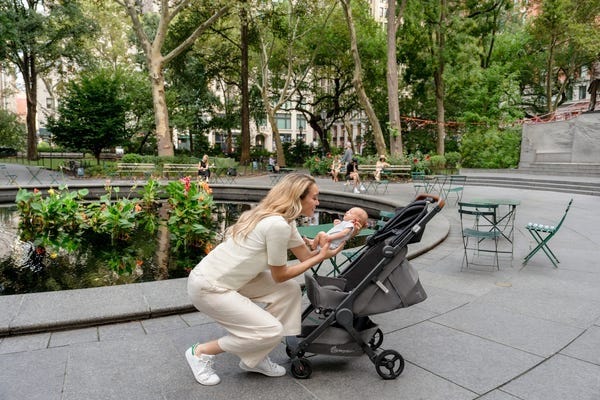

Advantages of Using Strollers for Nature Adventures
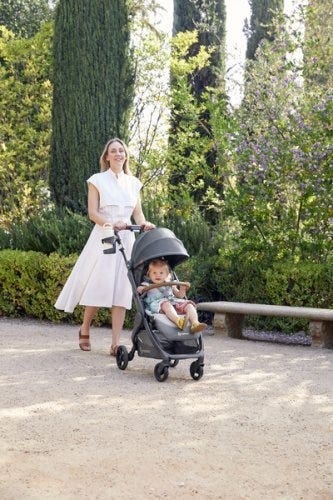

While baby carriers are fantastic for mobility and closeness, depending on the adventure of choice you might want to be a stroller along too.
There are a LOT of baby stroller options on the market. So we understand how confusing it can be to choose the one that’s right for your family. Not only are there a variety of brands, but a variety of strollers that serve different purposes.
There are a few types of strollers on the market:
- Full-sized stroller: This is typically the stroller parents thing of buying for all its versatility.
- Lightweight or umbrella stroller:These compact strollers are perfect for on-the-go adventures.
- Jogging stroller: Designed for parents who want to combine fitness with outdoor adventures.
- Double stroller: Designed for parents with multiple kids, especially twins.
- Car seat carrier: These strollers connect to a specific car seat. We don't typically recommend these as they can be unsafe for baby and uncomfortable for parents who are pushing.
Learn more about the types of strollers and which one would be best for you.
Benefits of Bringing a Stroller
- Storage Space for Gear: Ample room for carrying all your essentials like a diaper bag, beach toys and more.
- Shade and Weather Protection: Built-in canopies to shield your baby from the sun when they are lounging.
- Options: If you have more than one kid, you can stroll with one and carry the other. Or, if you’re getting warm or your little one is getting fussy, you can switch up their position from stroller to carrier or vice versa.
Safety Tips for Strollers
- Ensure your stroller is in good working condition. Make sure buckles are still buckling and that there are no rips or holes that could compromise your baby’s safety.
- Use sunshades or bug nets to protect your little one’s skin.
- Securing the baby properly: always buckle up your baby for safety even if you think they are old enough to go without the buckle.
Combining Baby Carriers and Strollers
For the ultimate flexibility, consider using both a baby carrier and a stroller on your outings.
Combining both options allows you to adapt to different situations. Use the carrier for more rugged trails and switch to the stroller for smoother paths or when your baby needs a nap.
Transition Tips
- Smooth Transitions: Plan stops where you can easily switch from carrier to stroller.
- Pack Light: Only bring essentials to make transitions easier.
Tips for a Successful Adventure
Planning Ahead
- Route Planning: Choose baby-friendly trails and parks. Check local mom groups or outdoor groups and get recommendations for the best outings for kids.
- Check Weather Conditions: Avoid extreme heat or unpredictable weather. Even with our most breathable carriers, when it’s hot, it’s hot. And having two bodies against each other in the heat will be naturally hot and sticky already.
- Packing Checklist: Include diapers, snacks, water, sunscreen, and a first-aid kit. These all-position carriers have storage pockets where you can fit some of the items easily!
- Stay Hydrated and Nourished: Pack healthy snacks to keep energy levels up and bring plenty of water for both you and baby.
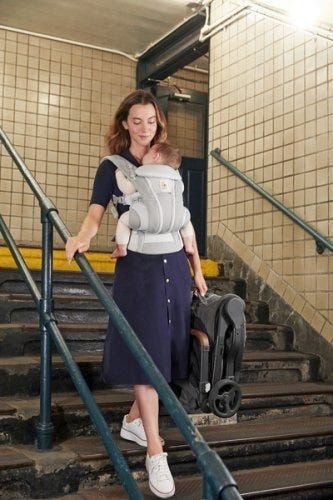

Summer adventures with your baby are a wonderful way to create lasting memories and enjoy the beauty of nature together. From baby carriers to strollers, Ergobaby products are designed to provide comfort and ease for both you and your little one. So, gear up, get outside, and explore the world with your baby by your side.
Ready to embark on your own summer adventures? Check out Ergobaby’s range of baby carriers and strollers to find the perfect match for your family’s needs. Visit our website today and start planning your next outdoor excursion!





